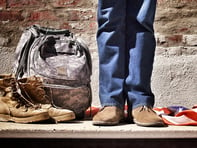Published on
Shaping the University to be Responsive to Veteran Student Needs

The following interview is with Mike Carrell, assistant provost and director of the Office of Military and Veterans Services at The Ohio State University. Ohio State was named to the Military Times’ recent Best for Vets list, no small achievement given the number of institutions that are vying to serve this unique and growing student demographic. In this interview Carrell, a retired US Air Force Colonel, shares his thoughts on what it takes to stand out in this marketplace.
1. What are the biggest challenges veteran students face when it comes to accessing higher education?
Where do they start? There’s so much information out there and if they just start with a Google search or anything like that, they’ll just be bombarded. The best advice I heard someone say is that they should treat it just like a mission they’ve had in the military and research it in the same way; find out the details of it and what they’re going to do as they show up on these campuses. Look at the accreditation of the school, find out if the university has a veterans office with dedicated resources and look at what their focus is on the campus.
If they don’t have some of those things we’re talking about, those should be major red flags to a veteran or military member who’s looking at where they should spend their money and time. It’s a major investment of both to get that degree.
2. Building on that, what are some of the challenges they face when it comes to persisting through a postsecondary degree?
For all veterans, they’re facing a three-fold transition. They’re transitioning to be a college student, first and foremost. They’re also going through a transition from the military culture to a civilian and a college culture. It’s leaving a mindset in the military that’s about the group welfare and the mission accomplishment—to the detriment of individual needs at many times—to an environment on our campuses where it’s all about the individual and you’re expected to take care of yourself and everything that you need. That can be a real challenge that we go through.
The last one for many of our veterans is they’re coming out of combat and that can be the hardest transition of them all. Then of course we ask them to make all three of those transitions at the same time when sitting next to their peers, [who] could be 10 years their junior, and our veteran is sitting there with a lot of different worries in life about their families or job or things like that. That can be very stressful on them as they go through that persisting and moving on to their degrees.
The good news is most schools are recognizing this and they’re providing some opportunities for ways for them to connect and overcome these challenges.
3. What are some of the things your institution has done to help veterans overcome these obstacles and succeed through their academic program?
First and foremost, the university, from our board of trustees to our president and down, is genuinely committed to this group with a focus on academics as our organizing principle.. We’ve greatly expanded the resources in people, money and facilities. We have the new Office of Military and Veteran Services, we’ve opened a student veteran lounge here on campus as a place for them to meet socially, we started three student veteran groups on our campus.
We always walk a fine line at universities between trying to help them make that transition and help them integrate again back into the civilian world and the college world. To that effect we started a peer-to-peer engagement program where we hired some of the student veterans to do what in the military is called a sponsorship program. They have someone that they can talk to who is sitting where they were a year ago who can show them around campus, show them where our office is, [and tell them about] other offices that can help them.
We have another program that we call student veteran community advocates and it’s a completely donor-funded program where we’re placing a handful of students in various offices around the campus. They’re acting as a liaison to that office to help faculty and staff learn about military and veterans issues on that campus and then they can also learn what [different offices] do for veterans or could do for students.
We started student veteran orientations and we do that on the first day they’re here, to tell them not to duplicate the academic orientations that they go to but to let them know, as a student veteran, here’s what’s available to help you in those transitions on our campus and also in our community. We have a VA clinic here in town, we have a lot of state federal resources we let them know about. They work a lot with our Buckeye Careers Office in trying to develop internships and employment for companies that want to hire on veterans but also just to help the students learn they should be engaged with the veterans career office from their first year.
4. In general, what does it take for a university to really stand out as an institution that provides a positive and supportive environment for veteran students?
First and foremost it’s a commitment from the total university. We like to say here that it’s not the veteran’s office’s job to own these military and veteran students but it’s really everyone’s. It’s great to want to support veterans, and everyone should, but why? It may be a little different at each university and that’s okay, but each institution needs to go through that because you’re going to get a lot of demands on your time and whatever money you do have available and you need to have a way to filter that and make decisions. In ours, it’s about academic success. That’s what we focus on and that’s what we use to choose between things. It’s about building trust with these students.
You need to listen to your students. Different students at different groups are going to want very different things. When I helped build the program here, I traveled around the country to various universities and I spoke with a lot of them. Each university population is a little different.
This interview has been edited for length.
Author Perspective: Administrator


